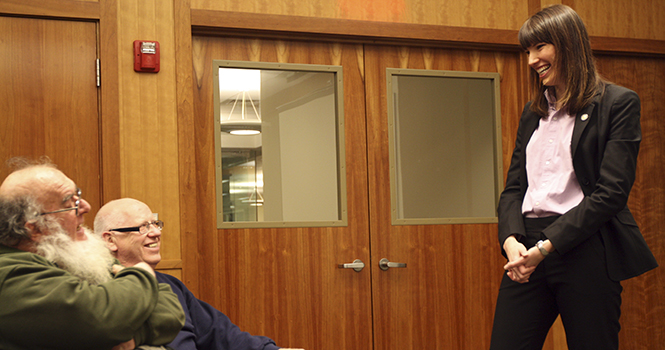State Rep, community members question governor’s proposed transportation bill
State Representative Kathleen Clyde talking with citizens before her speech on the new Ohio Budget on transportation at the Kent Free Library on February 18th. Photo by EMILY LAMBILLOTTE.
February 19, 2013
A new transportation budget proposed by Gov. John Kasich has State Representative Kathleen Clyde asking more questions than she feels are being answered.
“The transportation budget provides mainly for programs funded through out motor fuel tax and registration fees,” Clyde said Monday during a town hall meeting at the Kent Free Library.
Clyde’s presentation, “The Turnpike, Transportation and Infrastructure Funding & Ohio’s Budget,” is part of a series of town hall meetings Clyde is scheduled to present across Portage County. Each talk addresses one of the four state legislative topics included in Kasich’s bi-annual state budget plan introduced in early February.
The proposed budget, House Bill 25, is slated to cost about 7.6 billion dollars in state revenue, Clyde said. The tentative breakdown of that cost sets aside 6.1 billion dollars to O-DOT, 1.3 billion dollars to the Department of Public Safety, and 136 million dollars to the Public Works Commission. There are no increases included for public transportation.
General revenue funds, like income tax and sales tax, are not included as part of the transportation budget. Instead, all included funds come from the Ohio gas tax revenue (28 cents per gallon) and revenue from fees.
“The Turnpike” began Clyde’s series with a look at Kasich’s announcement that 90 percent of the money collected from Ohio Turnpike bonds would be spent in northern Ohio. Since that initial proposal, Kasich has retracted his statement, Clyde said.
“He kind of backed away from that and started saying a majority of those funds would be spent in northern Ohio,” Clyde said. “The governor started out with that proposal, but the proposal that was introduced has no language that says that the money will have to be spent in northern Ohio. In fact, we were told by the ODOT director Jerry Wray that that was a foolish expectation and that (ODOT) had no intention of putting that guarantee in (the proposal).”
Clyde added that Kasich’s definition of “northern Ohio” is unclear. The initial bill included nearly 1/3 of the state as northern, but that definition changed several times during discussion of the bill.
Compounding the confusion surrounding the transportation bill is a series of questions Clyde said Kasich has not answered. As it stands, the proposed bill does not address the prevention of toll increases, a point Kasich originally said would be included in the bill.
“The assurance that tolls wouldn’t go up for people travelling thirty miles or less is out,’ Clyde said. “I had concerns about the proposal as the governor was stating it. In December, the governor went on a public relations tour saying, ‘We’re not going to sell or lease the Turnpike, but instead, we’re going to borrow 1.5 billion dollars against the future revenues of the Ohio Turnpike to fund transportation projects.’ That’s not in the bill.”
Clyde asked a series of additional questions raised by the proposed transportation bill and invited Kent residents to add their own questions to the list:
- How could the Turnpike generate 1.5 billion dollars without increasing tolls substantially or degrading the quality of the road?
- How would maintenance be unaffected if two facilities are already closing?
- What is the governor’s definition of northern Ohio? “Right now the money that is generated by the Turnpike has to be spent within a mile of the Turnpike. There is a lot of concern about how that money could be spread around and not spent on the Turnpike or near the Turnpike,” Clyde said.
- Will northern Ohioans be double-taxed, or will the fuel tax be diverted?
- Could residents and businesses that regularly travel beyond the thirty-mile distance afford a toll increase?
- Will out-of-state trucks passing through Ohio begin using back roads not designed to handle heavy traffic to afford increased Turnpike tolls?
- Is it fiscally responsible to put Ohio into a 1.5 billion dollar debt for this one-time use of money?
Portage County engineer Mickey Marozzi said he hopes Kasich will answer these questions and more before an official bill passes.
“I am a little bit concerned about our ability to borrow 1.5 billion dollars out of the Turnpike and pay it back and maintain the maintenance to the level that all of us have become accustomed on that road,” Marozzi said. “We still have some debt on the existing Turnpike. That obviously must take priority.”
Clyde will address the issues of the main operating budget, the workers compensation budget and the industrial council budget at future meetings.
Contact Amy Cooknick at [email protected].
//
var adPlayed = true;
function playerVariables(){
var videofile = ‘RPA_Devaney_Transportation_PKG_1.flv’;
var videoPath = ‘rtmp://flashmedia.kent.edu/fms-jmc/tv2/’;
var adFileName = ‘TechHelpAd_11152012_600.flv’;
var videoAdPath = ‘rtmp://flashmedia.kent.edu/fms-jmc/kentWired/’;
var adlink = “http://support.kent.edu/software”;
var width = 665; //the width of the player
var height = 450; //the height of the player
var thumbnail = ‘http://www.staterinteractive.com/photos/spring11/0131tv2.jpg’; //the URL to the thumbnail image
videotoPlay(videofile,videoPath,videoAdPath,adFileName,width,height,thumbnail,adlink);}playerVariables();
Contact MOLLY DEVANEY at [email protected].
48 30

























